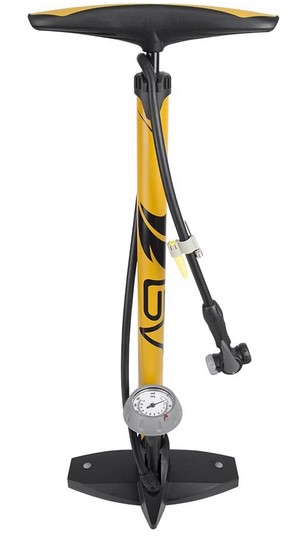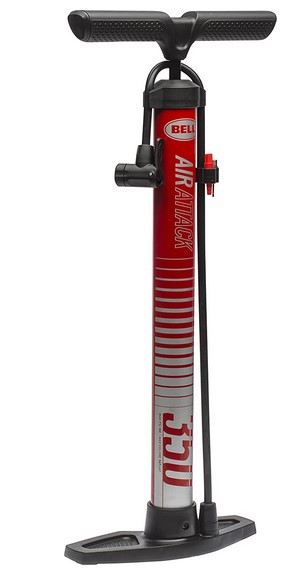You may consider using a ball pump to inflate your bike, especially if you don’t have a bike pump nearby. However, before doing so, is a bike pump the same as a ball pump?
A bike pump differs from a ball pump. Bike pumps are made to inflate bike tires while ball pumps inflate balls. Bike pumps have a special adapter or connection fitted into the tire valve to pump the bike tire, while ball pumps have a special needle facilitating ball inflation.
While you can use these pumps interchangeably to inflate your bike and balls, it would be best to use each pump for the intended use for proper efficiency and performance. I’ll explore this deeper later in the article.

Is A Bike Pump The Same As A Ball Pump? A Bike Pump vs A Ball Pump
It’s clear that while these tools are made to pump air into bike tires and balls, they are different, as indicated earlier. Although you can pump your bike with a ball pump, it’s not recommended since it doesn’t generate sufficient pressure to fill a bike tire.
1. Design
Bike pumps have an adapter or connection to be used with either a Presta or Schrader valves or both. While a third valve, Dunlop (woods), exists, bike tubes with this valve can use a Presta pump.
Ball pumps have an inflation needle that is fitted into the valve of the ball to allow inflation. The metal device passes the air from the pump to the ball.
2. Functionality
Each of these pumps is built to handle what it’s meant to do effectively. You require about 8.5 psi to fully inflate a football (soccer) or basketball, while about 60 to 121 psi inflates a 16 to 20-inch bike tube.
Most bike pumps can generate up to 160 psi or even more, but it’s quite rare for ball pumps to get to such levels. An excellent example of a pump with 160psi is the Vibrelli Bike Floor Pump (View on Amazon), which is also durable, stable, lightweight, portable, and made with exquisite construction.
Can You Use A Ball Pump On A Bike Tire?
You can use a ball pump on your bike tube if the nozzle fits into the valve to let air in. unfortunately, that isn’t easy to do.
In addition, even if you manage to do it, inflating your bike tires with a ball pump isn’t easy, and it will likely not produce enough pressure to fill the tube.
It’s also challenging to calculate the amount of pressure needed to inflate the bike tube when using a ball pump. Therefore, you have to press the tires manually to determine their hardness.
Don’t press the tire sides when checking if the tire is completely inflated.
Instead, press the tire from the outside to the inside with your hands. With that, you should be able only to push a centimeter in if it’s appropriately loaded.
It’s also time-consuming and requires plenty of effort to get it done. Instead, use a bike pump and only use a ball pump as a last resort for these reasons.
Can Bike Pumps Be Used For Balls?
You can use a bike pump to inflate a ball as long as you have an inflation needle to connect the pump to the ball’s valve. The good thing is inflation needles are found in most modern bicycle pumps.
Since bike pumps have more psi, you must be careful when using them on a ball. Make sure you monitor the inflation to protect the ball from blowing up due to excessive pressure.
What Are The Different Types Of Bike Pump?
Bike pumps are categorized into track/floor pumps, frame pumps, hand pumps, CO2 inflators, and shock pumps.
1. Track/ Floor Pump
Every biker should own a floor bike, and it should be among your first purchases when developing a home workshop. These pumps offer a pressure gauge, large quick air transfer chamber, and long flexible hose.
It gives you the most efficient and fastest way to inflate your tires and eliminates the workout and hassle of using a frame or mini pump to increase pressure before going for a ride.
If you are shopping for one, consider the BV Bicycle Ergonomic Bike Floor Pump (View on Amazon). It has an easy-to-read gauge, 160 psi maximum, and a comfortable ergonomically made handle.

2. Frame Pump
It’s a more efficient, longer hand pump built to fit within a bike frame’s triangle. It’s generally found only on touring and steel road bikes.
An excellent example of such a pump is the BV Mini Bike Pump Portable Frame Pump with a maximum of 120 psi and compatible with Schrader and Presta valves.
3. Hand Pump
It’s a portable pump made for occasional use and emergencies, so they are light and compact. The problem with these pumps is that they stress the valve stem, which eventually causes the inner tube to be useless or leaky.
4. CO2 Inflators
Compressed CO2 can help inflate your bike tires when you are in a hurry. Use it only if you get a flat on the trail or road since the cartridges are wasteful and expensive.
Before getting a CO2 inflator, check what cartridge sizes it can handle. For instance, the PRO BIKE TOOL CO2 Inflator is designed for all threaded CO2 cartridges of all sizes ( 25g, 20g, 16g, and 12g), Schrader and Presta Valve, and ideal for mountain and road bike tires.
5. Shock Pump
It’s a worthy investment for bikers with a mountain bike that has an air-sprung suspension. It’s a small volume, high-pressure pump with a maximum of 300psi.
A good example is the GIYO High Pressure Shock Pump (View on Amazon) with 300 psi maximum. It’s designed for inflating rear and fork suspension with a Schrader valve on a mountain bike.
How Do I Choose A Bike Pump?
By now, it’s clear that it’s better to use a bicycle pump on your bike tires. Every cyclist should know and be ready to inflate a flat tire and maintain their tire pressure.
For this, you need a quality bike pump to add to your bicycle tool kit. When shopping for a bike pump, pay attention to the pressure, volume, size, weight, gauge accuracy, construction, and the type of valve.
1. The Needed Pressure
Not a lot of people require a 260psi bike pump. Higher pressure is typically a volume output, or at the very least, a gauge accuracy trade-off; that’s why some manufacturers offer mountain or road biking specific pump models.
2. The Needed Volume
Like pressure, volume depends on your bike. A high-volume bike pump uses fewer strokes to provide the desired pressure, which means the maximum pressure is lower.
Since the tires in mountain bikes have lower pressure and greater volume, it’s essential to have a large volume bicycle pump. An excellent example of such a pump is Bell Air Attack 350 High Volume Bicycle Pump Red Stripe with a wide barrel construction and reversible Presta/Schrader head.
A huge volume output bike pump is sufficient to seat tubeless tires without an air compressor.

3. Valve Types And Pump Heads
The standard valve types are Schrader and Presta, but you can also go for Dunlop. Almost all bike pumps accommodate at least Schrader and Presta valves.
While some bike pumps are specific to certain valves, others must be changed internally to accommodate various valves. A smart head adjusts automatically to different valve sizes, while a twin-valve head has two different slots for each valve.
A thread-on style offers a reliable fit, but you must change and flip it according to the valve you need.
4. Size
Size won’t be a problem if you intend to use your pump at home. However, if you plan to take it around with you, go for a smaller pump.
5. Weight
Weight shouldn’t be an issue if you don’t intend to carry the pump with you. Today’s most pricey bike pumps are lightweight aluminum-made or even carbon fiber, but you can also go with plastic ones, which also work well.
While weight is essential, don’t choose low-weight at the expense of vital features. However, there’s no need to carry the additional weight if it’s not necessary.
6. Construction
While it’s not always the case, a bike pump’s construction quality directly relates to its price. This is why expensive bicycle pumps have more metal in them, making them more durable.
7. Gauge Accuracy
Although few hand bike pumps have a gauge, they should be present in any good track pump. Find a pump with easy to read meter that provides the ideal pressure range you require.
FAQs
1. Can I Pump Up A Basketball With A Bike Pump?
You can pump a basketball using a bike pump if you have an inflation needle and use lube to insert the needle seamlessly. If your pump has a gauge, inflate the ball until you achieve the ball’s psi that’s usually indicated on the ball.
If your bike pump doesn’t have a gauge, inflate the basketball until it gets hard.
2. Can You Use A Bike Pump To Inflate An Exercise Ball?
You can inflate an exercise ball with a bike pump if you have an inflation needle. Connect the inflation needle to the valve of the ball with the aid of lube, then start pumping, but do not overinflate it to protect the ball from bursting.
3. What Can I Use Instead Of A Bike Pump?
You can pump your bicycle using a CO2 inflator or compact compressed air when you don’t have access to an air compressor or a bike pump. A ball pump may also work, but it’s less effective (doesn’t offer enough pressure), needs more effort, and is more time-consuming.
4. How Do You Pump Up A Bike Tire With A Ball Pump?
You’ll need to determine the required psi to inflate your bike tires fully, ensuring it’s accurate to avoid tire bursts from too much pressure. You’ll then connect the ball pump’s nozzle to the bicycle tire valve then begin inflating until it’s complete.
Closing Remarks: Is A Bike Pump The Same As A Ball Pump?
Besides serving their intended purposes, it’s clear that a bike pump can also inflate a ball, and a ball pump can inflate a bike tire as well. However, I recommend purchasing a bike pump specifically for your bike instead of using a ball pump to inflate it unless it’s your last resort.
Get a bike pump that suits your needs to ensure you have enough pressure in your tires at all times.
Also Read:
